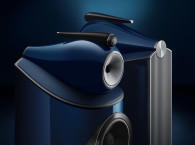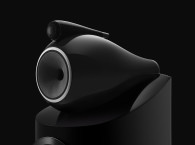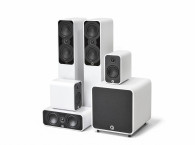On the eve of the company’s 50th anniversary, Bowers & Wilkins introduced a reimagined 800 Series Diamond loudspeakers. The new range features new midrange drivers with a composite cone material replacing the Kevlar and a new curved cabinet design. Even the famous diamond tweeter domes received a new motor system.

“The new 800 Series Diamond massively elevates loudspeaker performance, even compared to Bowers & Wilkins highly regarded previous efforts.” That’s how the English company and one of the most prestigious loudspeaker brands described its reimagined 800 Series Diamond, announced on the eve of the company’s 50th anniversary. Its been almost 40 years since the 800 Series from Bowers & Wilkins have established a true high-end audio standard, generation after generation.
 The result from an intensive seven-year project, Bowers & Wilkins says its latest 800 Series Diamond “redefines what is possible from a loudspeaker system. A combination of tireless research and development, advanced engineering, and countless hours of listening by the very best ears in the business have produced a range of loudspeakers that places the listener closer to the recording than ever thought possible. The improvement can be heard from the first note.”
The result from an intensive seven-year project, Bowers & Wilkins says its latest 800 Series Diamond “redefines what is possible from a loudspeaker system. A combination of tireless research and development, advanced engineering, and countless hours of listening by the very best ears in the business have produced a range of loudspeakers that places the listener closer to the recording than ever thought possible. The improvement can be heard from the first note.”The company says that almost all of the component parts are different from the outgoing 800 Series Diamond. As Bowers & Wilkins Head of Research Martial Rousseau says, “This is not an update. This is a completely re-imagined design. One of the few remaining elements is the Diamond tweeter. We found it impossible to improve on the performance offered by diamond, although behind the diamond dome, the motor system was improved considerably.”
The rest of the loudspeaker has been completely redesigned, starting with improved cabinets, totally new Continuum midrange drive units and a more robust Matrix bracing system. The cabinet design is now completely curved in front and sides, with a single joint of solid aluminum. The internal structure (matrix) now uses thicker internal panels of solid plywood and the base of the speakers is more stable and resonance-resistant, with a new plinth constructed from a solid piece of aluminum and integrated floor spikes that can be lowered or raised.
 A new composite cone, developed in-house by Bowers & Wilkins engineers, replaced the Kevlar cones that have long been a major factor of the 800 Series’ famously realistic midrange performance. The design of the 800 Series Diamond midrange chassis has been completely overhauled, now offering superior stiffness, while tuned-mass dampers help to reduce unwanted vibrations to a bare minimum.
A new composite cone, developed in-house by Bowers & Wilkins engineers, replaced the Kevlar cones that have long been a major factor of the 800 Series’ famously realistic midrange performance. The design of the 800 Series Diamond midrange chassis has been completely overhauled, now offering superior stiffness, while tuned-mass dampers help to reduce unwanted vibrations to a bare minimum.Bass performance has also been dramatically improved by the introduction of the Aerofoil cone, which considerably reduces distortion thanks to a new variable profile cone geometry and more advanced sandwich construction. By using advanced computer modeling and a new syntactic core material, B&W has been able to produce a cone of varying thickness, with maximum stiffness where it’s needed most. This optimized shape means the cone displays pistonic behavior further up the audible range, producing more precise and controlled bass.
There is also a new solid body tweeter assembly and an improved Turbine head midrange enclosure, all designed to reduce distortion dramatically. The tweeter assembly is housed in a solid piece of aluminum, while an improved gel decoupling system isolates the tweeter from the effects of cabinet resonance. The famous turbine head, introduced in the first 800 Series speaker in 1979, is now constructed from a single piece of aluminum, braced with internal radial fins and with a raised, slimmer profile.
 The new industrial design is both a radical departure and, paradoxically, a subtle change that preserves Bowers & Wilkins’ unique design aesthetic. The new 800 Series Diamond speakers are slender and more modern, while remaining true to Bowers & Wilkins long tradition. With distinctive aluminum pods on all models securing and decoupling drivers from the enclosure, and the Turbine head constructed from a single piece of aluminum sitting on a sleek reverse-wrap cabinet on the “headed” models, the luminously finished cabinets are crafted from layers of wood, curved into shape under intense pressure.
The new industrial design is both a radical departure and, paradoxically, a subtle change that preserves Bowers & Wilkins’ unique design aesthetic. The new 800 Series Diamond speakers are slender and more modern, while remaining true to Bowers & Wilkins long tradition. With distinctive aluminum pods on all models securing and decoupling drivers from the enclosure, and the Turbine head constructed from a single piece of aluminum sitting on a sleek reverse-wrap cabinet on the “headed” models, the luminously finished cabinets are crafted from layers of wood, curved into shape under intense pressure.Testament to Bowers & Wilkins desire to manufacture consistently class-leading loudspeakers, the entire manufacturing plant in Worthing, West Sussex, UK was redesigned specifically for production of the new 800 Series Diamond – a enormous investment in tooling, materials and processes to ensure that every model produced is a perfect replica of the reference master.
 The 800 Series Diamond range
The 800 Series Diamond rangeFrom the studio-quality 802 D3 to the more accessible 805 D3, the new 800 Series Diamond range also tries to broaden its appeal to a wider market. The 802 D3 model targets larger domestic spaces as well as recording environments, while the 803 D3 directly targets medium sized living rooms. The more affordable 804 D3 will address the general high-end market and the 805 D3 will offer a more compact stand-mount alternative that still features the famous Diamond dome tweeter.
Bowers & Wilkins also designed the HTM1 D3 center speaker, designed to partner with either the 800 D3 or 802 D3, and there is also the DB1 subwoofer to create complete surround configurations. The HTM2 D3 is a compact center channel designed for the smaller speakers in the 800 Series Diamond range.
 According to the company, general availability is expected for early October 2015 with only the flagship Model 800 D3 confirmed for Spring 2016. The new range includes the 802 D3 ($22,000 pair), 803 D3 ($17,000 pair) and 804 D3 ($9,000 pair) - all floorstanding models - plus the standmount 805 D3 ($6,000 pair) and two center-channel speakers for home cinema applications, the HTM1 D3 ($6,000 each) and HTM2 D3 ($4,000 each). Floor stands to match the main speakers cost $500 each.
According to the company, general availability is expected for early October 2015 with only the flagship Model 800 D3 confirmed for Spring 2016. The new range includes the 802 D3 ($22,000 pair), 803 D3 ($17,000 pair) and 804 D3 ($9,000 pair) - all floorstanding models - plus the standmount 805 D3 ($6,000 pair) and two center-channel speakers for home cinema applications, the HTM1 D3 ($6,000 each) and HTM2 D3 ($4,000 each). Floor stands to match the main speakers cost $500 each.www.bowers-wilkins.com






